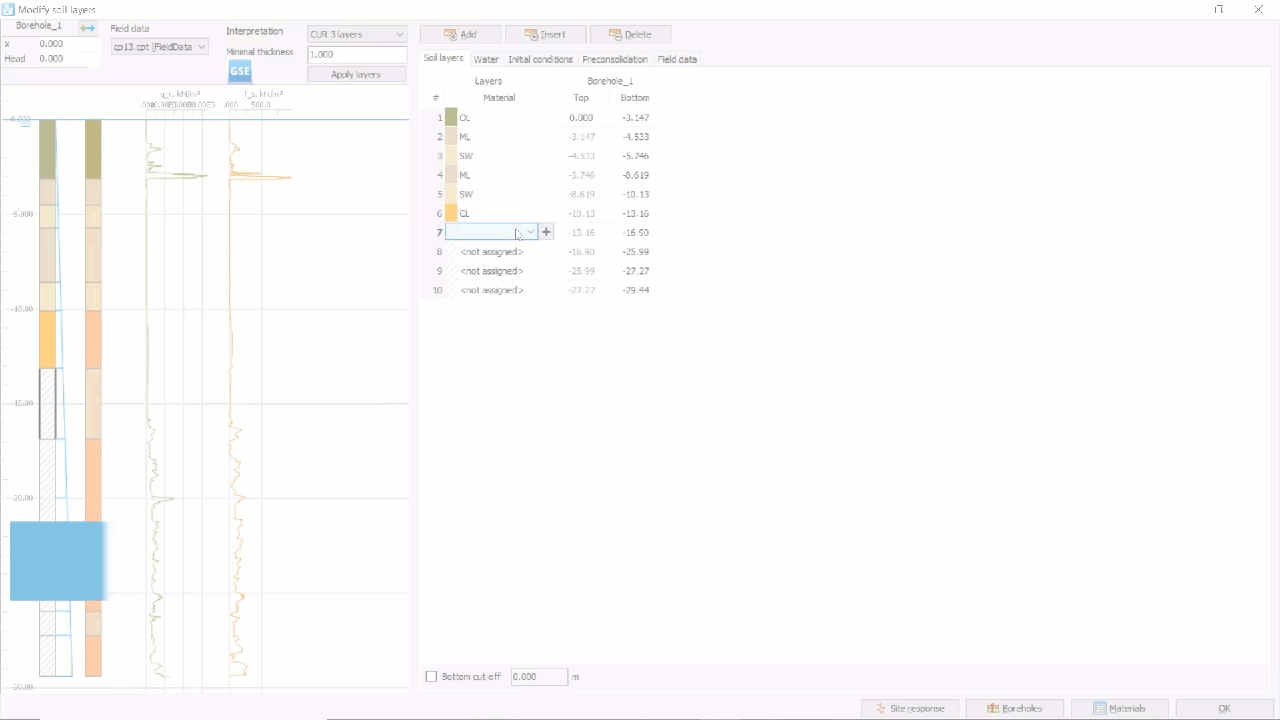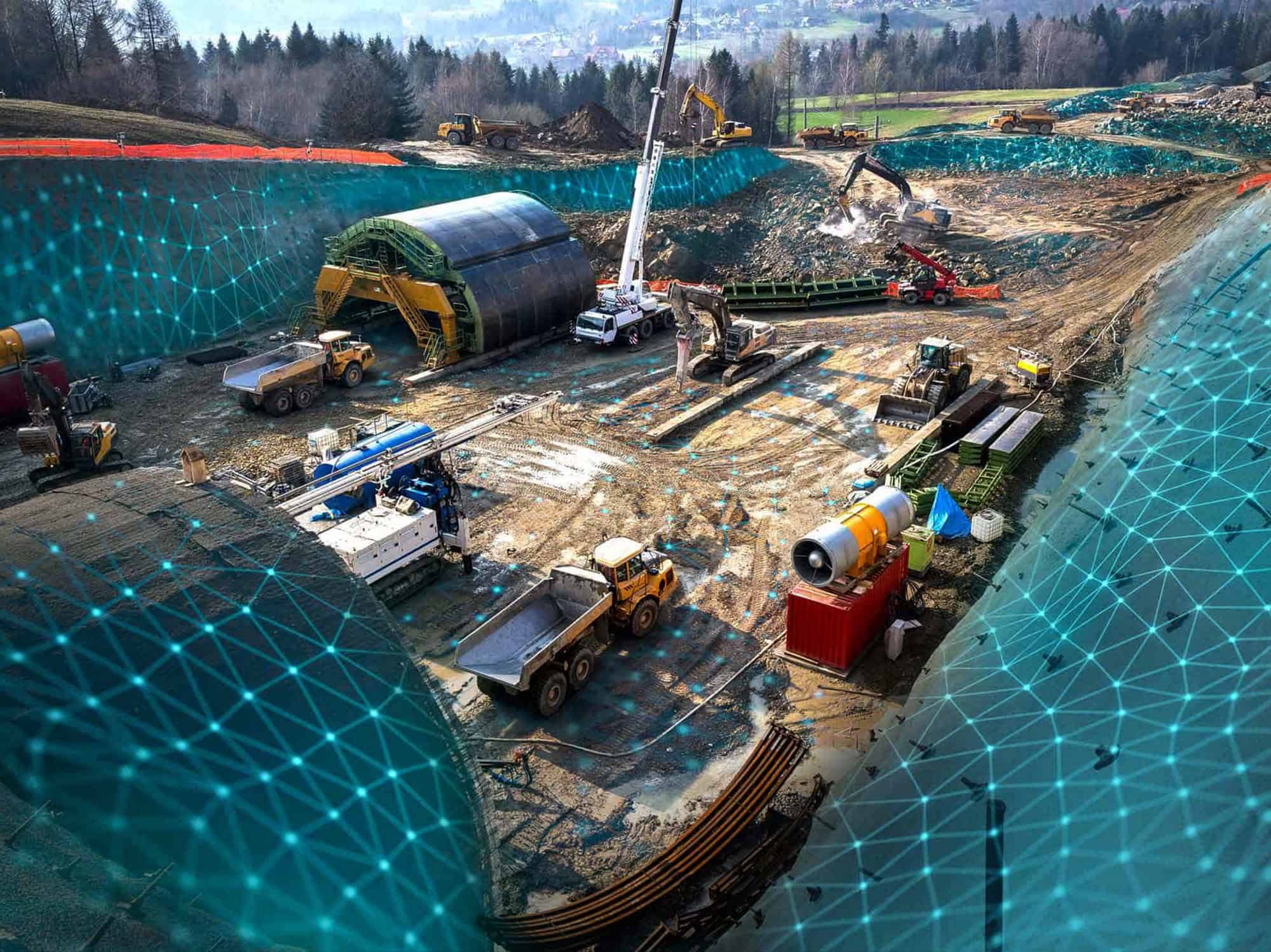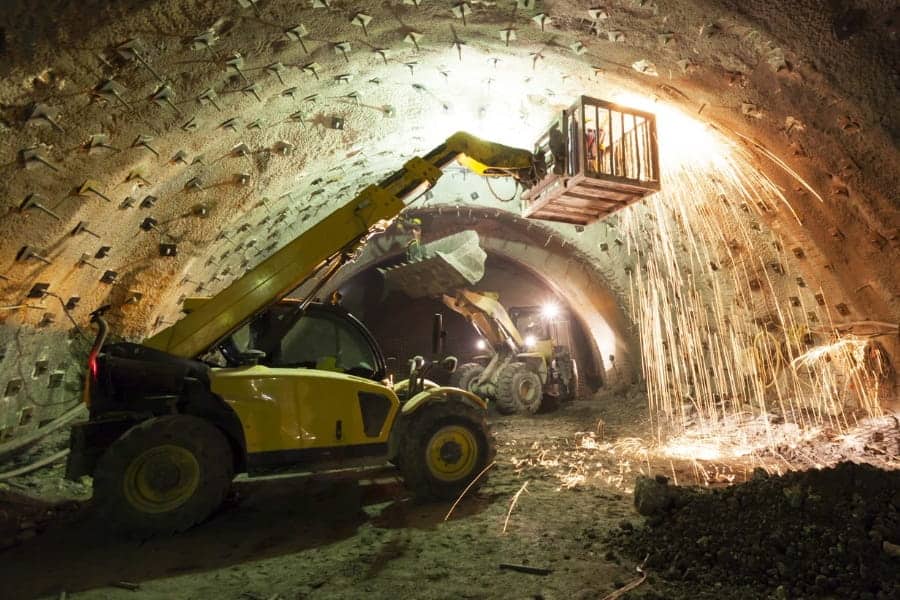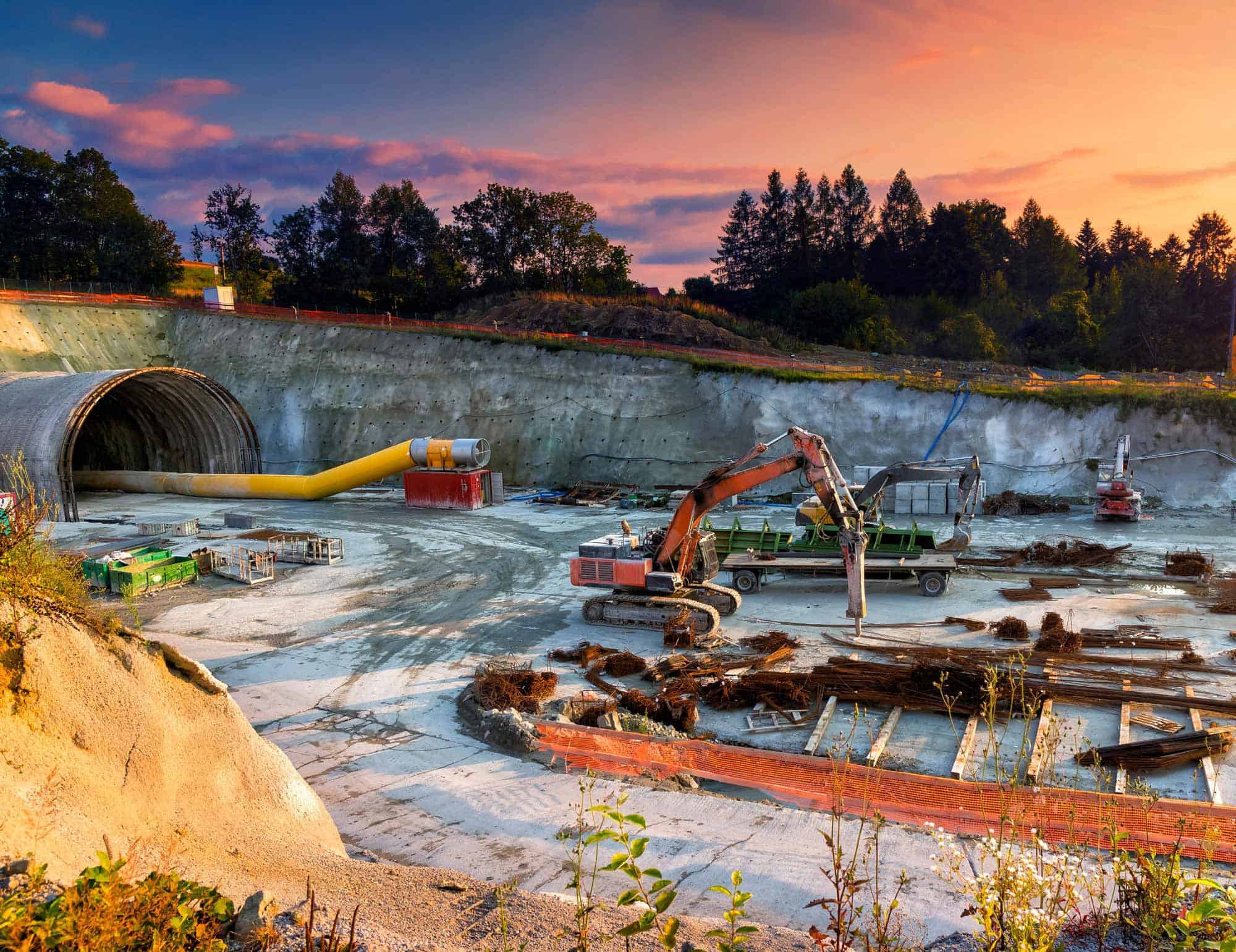In our last blog post, we discussed advanced material models in PLAXIS 2D, PLAXIS 3D. In this article, we will look at the specialized material models you can use in PLAXIS, commonly known as User-Defined Soil Models. If you want to discuss the specialized material models you want to use, you can contact a PLAXIS expert here or find more information at Bentley Communities.
UDSM – Creep-SCLAY1S
The Creep-SCLAY1S model is capable of simulating the anisotropic and rate-dependent behaviour of soft soils. The mathematical formulation also includes the possibility to model bonding and destructuration. Many constitutive models have been proposed in literature to describe the behaviour of structured natural clays. Most of the rate-dependent models were developed based on the Perzyna’s (Perzyna (1963) and Perzyna (1966)) overstress theory (e.g. Hinchberger & Rowe (2005) and Zhou, Yin, Zhu & Cheng (2005)), with the disadvantage of a difficult parameter calibration process (Karstunen & Yin (2010)). Another approach consists in using empirical formulations, as for example the Soft Soil Creep model available in the PLAXIS standard library. The Creep-SCLAY1S can be considered a special kind of extended overstress model derived from an empirical equation (Sivasithamparam, Karstunen & Bonnier (2015))
UDSM – Frozen and Unfrozen Soil Model
The Frozen and Unfrozen Soil model constitutes a soil model implemented in PLAXIS, capable of describing the mechanical behaviour of frozen soils as a function of temperature, up to the unfrozen state and vice versa. The present constitutive model is the result of a collaboration between the Norwegian University of Science and Technology (NTNU) and Plaxis bv. The aim of this model is to provide a reliable design tool to evaluate the influence of climate/temperature changes in a variety of engineering problems. The increase of engineering activities in cold regions, projects involving artificial ground freezing and consequences of global warming lead to geotechnical applications which deal with frozen/unfrozen ground.
The constitutive model developed by Amiri, Grimstad, Kadivar & Nordal (2016) characterises the mechanical behaviour of frozen soils as a function of temperature, up to the unfrozen state and vice versa. The Frozen and Unfrozen Soil Model is implemented as a user-defined soil model (UDSM) in PLAXIS, using the fully coupled THM calculation options.
UDSM – Generalized Hardening Soil Model
It is observed in simulations of excavation projects using the Hardening Soil model (or HS small model) that the soil below the bottom of the excavation behaves less stiff than in reality. The reason is that the stiffness of soil is stress dependent and excavation releases the stress on top, however, in reality, the stiffness will not reduce so much due to the pre-consolidation stress. Therefore, in the GHS model (generalized hardening soil model) the stress dependency formulation of the Hardening Soil small model has been altered in order to account for the pre-consolidation stress. The Generalized Hardening Soil model (GHS) is a more modular version of the original Hardening Soil small model. It has several switches which allow the users to change the configurations of strain and stress dependency.
UDSM – Hoek & Brown model with softening
Hoek & Brown (HB) failure criterion has been often employed over the past decades in practical engineering applications due to its intrinsic capability to capture the non-linear behaviour of different types of rocks. The former idea of HB (Hoek, 1968; Hoek and Brown, 1980), was to link some concepts of fracture mechanics and the macroscopic response resulting from the non-linear trend of the initial yielding. To formulate a mathematical expression of the initial yield surface and describe the rock-mass behaviour, the Uniaxial Compression Strength (UCS) of the intact rock and some dimensionless constants obtained from empirical correlations (i.e., the constants mb, s and a) have been used to define the HB criterion.
This approach has been further improved by several authors (Marinos et al., 2005) who have used empirical data recorded from field observations at different environmental conditions to characterize the mechanical properties of the rock-mass. For this purpose, the Geological Strength Index (GSI) and the Damage factor (D) have been used to define the material parameters of the HB yield surface.
This Hoek & Brown model implemented in PLAXIS refers to the formulation proposed by Jiang (2017) which can guarantee at the same time smoothness and convexity of the yield surface and plastic potential. The underlying implementation is further enhanced with the following constitutive features:
The initial non-associativity with the ability to simulate the non-linear evolution of the dilation in the postpeak regime;
A softening rule implemented through two different formulations;
A tension cut-off in the tensile regime of the stress space;
A rate-dependent version of the HB model is here used to solve the mesh-dependency of the numerical solution when the brittle failure is characterized by a strong concentration of strain in narrow shear bands.
UDSM – Hypoplastic model with inter-granular strain
Sand hypoplasticity is an advanced incrementally non-linear constitutive model, an outcome of extensive research at Karlsruhe University in 1990’s. It incorporates pressure- and density-dependency of soil behaviour. Its response has been validated using a number of single and finite element simulations of various geotechnical problems. When combined with the so-called intergranular strain concept, it is capable of predicting small strain stiffness degradation and cyclic loading effects.
The Hypoplastic model is available as a user-defined soil model Dynamic Link Library (DLL). This DLL can be obtained from and is supported by Plaxis. However, Plaxis does not accept any responsibility when using this DLL. Hence, the user needs to validate the results obtained from this model by him/herself.
UDSM – Isotropic Jointed Rock with Mohr-Coulomb Failure Criterion
The Jointed Rock model with overall Mohr-Coulomb failure criterion (Iso-JRMC) has been developed as a user-defined soil model. It is a combination of the Jointed Rock model (with isotropic elastic part) and the Mohr-Coulomb model.
Plasticity will primarily occur in (up to) three stratification or fault directions (planes) using cohesion, friction angle, dilation angle and tensile strength on each plane, whilst an overall MC criterion (based on principal stresses) will be considered in all directions.
The advantage of this model over the standard Jointed Rock model in PLAXIS is that the latter may lead to ‘locking’ if a potential failure mechanism requires other than the predefined failure directions to develop. The Iso-JRMC model will overcome the ‘locking’ since it may (eventually) fail in other directions as well (according to the overall Mohr-Coulomb criterion), such that a continuous failure mechanism may be obtained.
A limitation of the Iso-JRMC model is that the elastic behaviour is isotropic.
UDSM – Masonry
The masonry model (Amorosi et al., 2015; Amorosi et al., 2018, Lasciarrea et al., 2018) is a linear elastic perfectly plastic model aimed to simulate the macroscopic, anisotropic response of unreinforced masonry structures. In this model, a Coulomb criterion is used to simulate the failure in the predefined directions and an overall Mohr-Coulomb criterion is used to represent a failure of the masonry blocks. It is based on the anisotropic Jointed Rock constitutive model, a user-defined model implemented in PLAXIS which has a constitutive law that takes into account the directional properties of the medium and orientation of maximum three failure directions along which a Coulomb failure criterion applies.
Masonry structures are heterogeneous media which have relatively large intrinsic stiffness and strength of the blocks as compared with those of the joints. Hence, the behavior under loading is strongly influenced by the joint properties, texture and geometrical size. The direct approach to model these assemblies is a discrete or discontinuous modelling, where the blocks and joints are treated separately. However, these models can be hardly used in practice due to discretization of individual bricks and joints, leading to numerical difficulties and computational demands (de Buhan et al., 1997). The alternative is a continuum-based approach where the structure is regarded as an anisotropic medium with a constitutive relationship that describes the overall behavior. The Masonry model is a macroscopic model for block masonry defined by a limited number of geometrical and mechanical parameters with most of them coincide with those of the original Jointed Rock model. It has two sets of failure planes in which the strength parameters are defined using the Coulomb failure criterion. The geometrical character of a single brick is reflected using an additional Strength Factor parameter. The isotropic elastic parameters that define the overall masonry response are needed. If elastic properties of bricks and joints are available, a closed-form approximated expression of the macroscopic elastic strain energy as derived by homogenization by (de Felice et al., 2010) can used to derive the overall elastic parameters.
UDSM – OC-Clay
A Constitutive Model for Overconsolidated Clay based on the Hardening State Parameter
Natural deposits are often characterized by a given degree of over-consolidation resulting from a wide range of geological processes and human activities (erosion, melting of glaciers, cyclic loading, water table variations, etc). Their presence in highly populated urban areas may have an important effect on the geotechnical design of structures like foundations, tunnels and excavations. From a modelling standpoint, although the formulation of the Original and Modified Cam-Clay model (MCC) explains the fundamental mechanisms of normally consolidated clays, the applicability of these constitutive theories to simulate the behaviour of Over-Consolidated Clays (OCC) show a limited model performance due to:
- The existence of a large elastic region.
- A quick transition from the elastic to plastic regime.
- An inadequate prediction of the peak stress and dilatancy on the dry side (i.e., the so-called supercritical region).
Compared with normally consolidated clays, over-consolidated clays are characterized by a lower void ratio, a higher strength stress and exhibit a stress dilatancy in combination with strain softening failure during the postpeak regime (Yao et al., 2008 ).
To fill this gap, several formulations have been proposed in the past to better capture the salient features of an OCC deposit (Pender, 1978; Hueckel et al., 1992; Whittle, 1993; Mita et al., 2004; Yao et al. 2009; Gao et al., 2017; Chen and Yang, 2017; Sternik, 2017). Recently, a model using a state parameter as a fundamental variable to characterize the consolidation process of a clay has been implemented by Jockovic and Vukicevic (2017) to mimic the behavior of OCC, thus showing the applicability of this approach for this class of materials. Specifically, the framework of critical state mechanics has been combined within a bounding surface approach through the definition of a state parameter.
The PLAXIS implementation of the HArdening State Parameter (HASP) model (Jockovic and Vukicevic, 2017) is presented to show the capability of these constitutive equations in simulating laboratory experiments on OCCs. To improve the model performance, the Small-Strain Overlay model (Benz, 2007) is integrated in the HASP framework to better capture the non-linear degradation of the shear properties which are crucial to evaluate the deformability of geotechnical structures. After the material calibration, some practical problems solved with the HASP model and PLAXIS 2D/3D code are also presented.
UDSM – SHANSEP MC model
The SHANSEP MC model (Stress History and Normalized Soil Engineering Properties) constitutes a soil model implemented in PLAXIS, intended for undrained soil loading conditions. It is based on the linear elastic perfectly-plastic Mohr-Coulomb model, but modified such that it is able to simulate potential changes of the undrained shear strength su (cu) based on the effective stress state of the soil. It takes into account the effects of stress history and stress path in characterizing soil strength and in predicting field behaviour.
UDSM – SHANSEP NGI-ADP model
The SHANSEP NGI-ADP model is an advanced constitutive model developed to enable the analysis of dikes and embankments according to the new design requirements (based upon undrained Critical State calculations) within a FEM environment. It overcomes limitations of the traditional NGI-ADP model with respect to the varying undrained shear strength of soils due to load history. Three additional input parameters are needed for this model, namely α, m and sAu,min. They are used to calculate (update) the undrained shear strength sAu dependent on the effective stress history by using the SHANSEP concept. The effect of parametersα and m was investigated and the results show that the effect of α is more dominant. However, the range of variation of these two parameters is short.
The SHANSEP NGI-ADP model in combination with other constitutive models
Apart from using the SHANSEP NGI-ADP model merely as a NGI-ADP model and then switching to the SHANSEP concept as described in the attached document, it is possible to use it as an ‘extension’ of any other constitutive model implemented in PLAXIS.
The process to switch from another soil model to the SHANSEP NGI-ADP model is described in the document as well, by uing the Special option parameter to activate the SHANSEP concept and by changing the the material of the soil cluster to the SHANSEP NGI-ADP model.
UDSM – Swelling Rock Model
The Swelling Rock model is a user-defined model that can be used to simulate the time-dependent anisotropic swelling of rocks.
The model was originally implemented by Prof. Thomas Benz of NTNU and further developed by Bert Schädlich of TUGraz for PLAXIS. The model is based on previous work by Wittke-Gattermann & Wittke (2004), Anagnostou (1993) and Heidkamp & Katz (2002) and can account for the stress- and time dependency of swelling deformations. The model is available as a user-defined soil model Dynamic Link Library (DLL). This DLL can be obtained from and is supported by Plaxis. However, Plaxis does not accept any responsibility when using this DLL. Hence, the user needs to validate results obtained from this model by him/herself.
Note that the current implementation of the model cannot be used in PLAXIS 3D.
UDSM – Visco-elastic perfectly plastic model
The visco-elastic perfectly plastic model is a simple and robust model that can be used to model time-dependent behaviour (creep and relaxation) of various materials. It is available as a user-defined soil model Dynamic Link Library (DLL). This DLL can be obtained from and is supported by Plaxis. However, Plaxis does not accept any responsibility when using this DLL. Hence, the user needs to validate results obtained from this model by him/herself.
UDSM – PM4Sand
With the release of PLAXIS 2D 2018, a new User Defined Soil Model for liquefaction analysis is introduced, the PM4Sand model (Boulanger & Ziotopoulou, 2017).
The PM4Sand model is defined in the framework of the stress-ratio controlled, critical state compatible, bounding surface plasticity model for sand by Dafalias & Manzari (2004). The model successfully simulates material behavior of sands in dynamic loading, including the pore pressure generation, liquefaction and post-liquefaction phenomena. It is a very attractive model for the industry due to a small number of parameters to be calibrated, mostly related to the usually available data in the design practice. Note that this model has currently only been tested and validated for 2D applications.
UDSM: N2PC-Salt
Rock, especially rock salt, exhibits time-dependent behaviour. Creep of rock and rock salt is related to various applications in civil engineering, the mining industry or petroleum engineering, such as energy storages, wellbore stability in oil and gas extraction, radioactive waste facilities design, etc. (Cornet, Dabrowski & Schmida, 2018).
For instance, drilling a deep borehole (around 5000m of depth) for oil extraction could face a serious instability problem when going through a creeping salt layer (see Dusseault, Maury, Sanfilippo & Santarelli (2004)). Most of the underground applications are concerned with large time scales (tens to thousands of years or even longer) and thermal effects at great depth (hundreds to thousands of meters of depth). The Norton power creep law (Norton, 1929) is widely used for describing the steady state creep behaviour, which is relevant for those large time scales.
In this context, an enriched version of the Norton law, the Norton-based Double Power Creep (N2PC) model for Salt Rock, including temperature effects, was implemented in PLAXIS software. Although the model is particularly adapted for creep of rock salt, it can be used also for other types of rock which exhibit similar creep behaviour.
Other available User Defined Soil models that can be used inside PLAXIS:
Please note: The models mentioned below are available as user-defined soil models. However, Plaxis does not accept any responsibility when using this DLL. Hence, the user needs to validate results obtained from this model by him/herself. Plaxis does not provide support on the use of this model.
UDSM – Anisotropic Clay Models: S-CLAY1 and S-CLAY1S
S-CLAY1S is an elasto-plastic model that account for initial and plastic strain induced anisotropy via a rotational hardening law. In addition, the model accounts for bonding and destructuration by using the concept of an intrinsic yield surface. By setting the model parameter controlling bonding to zero, S-CLAY1S reduces to S-CLAY1 model that accounts for anisotropy only, and furthermore, by setting the parameters related to anisotropy to zero, S-CLAY1S reduces to the isotropic Modified Cam Clay model. The values for the model parameters for S-CLAY1 and MCC models can be derived from conventional oedometer and triaxial shear tests (CU or D). In order to model bonding and destructuration with the S-CLAY1S model, an oedometer test on reconstituted sample is required together with a measure of the sensitivity.
- For more information and to obtain the model please contact:Prof. Dr. Minna Karstunen
Department of Civil and Environmental Engineering
Chalmers University of Technology
Sven Hultins Gata 8
SE-412 96 Göteborg
Sweden
Tel. +46 31 772 2144
Email: minna.karstunen@chalmers.se
UDSM – CLoE Hypoplastic Model
CLoE hypoplasticity — where the acronym CLoE stands for Consistance et Localisation Explicite.
- For more information and to request the model please contact:Prof. Gioacchino (Cino) Viggiani
Laboratoire 3SR
BP 53
38041 Grenoble Cedex
FRANCE
tel: +33 4 76 82 70 38
fax: +33 4 76 83 70 00
e-mail: cino.viggiani@3sr-grenoble.fr
UDSM – MIT S1 Model
The MIT S1 model describes the rate-independent behaviour of clays, sands and silts within a unified elasto-plastic formulation.
- For more information and to request the model, please contact:Prof. Andrew J. Whittle
Department of Civil & and Environmental Engineering
Massachusetts Institute of Technology
Room 1-353
77 Massachusetts Avenue
Cambridge, MA 02139
USA
tel: +1 617 253 7122
fax: +1 617 253 6044
e-mail: ajwhittl@mit.eduProf. Juan M. Pestana
GeoEngineering, Department of Civil and Environmental Engineering
421 Davis Hall
University of California, Berkeley
MC-1710 Berkeley, CA 94720-1710
tel: +1 510-643-0809
e-mail: pestana@ce.berkeley.edu
UDSM – Mixed Isotropic-kinematic Hardening Elastoplastic Models for Structured Clay
M2S and M1S
M2S is a two surfaces mixed isotropic-kinematic hardening plasticity model for natural soils obtained by hierarchically extending the Modified Cam-Clay model to include an early development of non-linearity, improved memory of stress history, anisotropy and the effects of structure and its degradation with plastic straining.
M2S reduces to M1S when only a single yield surface is considered. This latter model is implemented in Plaxis with a fully implicit stress-point algorithm ensuring numerically stable and first-accurate solutions at the Gaussian point level even in presence of stronly non-linear material response.
- For more information and to obtain the model, please contact:Dr. Daniela Boldini
University of Bologna
Dept. of Chemical, Mining and Environmental Engineering
via Risorgimento 2, 400136 Bologna (Italy)
tel: +39-051-2093390
fax: +39-051-2093392
e-mail: daniela.boldini@unibo.itProf. Angelo Amorosi
Technical University of Bari
Dept. of Civil and Environmental Engineering
Geotechnical Section
Via E. Orabona 4, 70125 Bari (Italy)
tel: +39 (0)80-5963693
fax: +39 (0)80-5963675
e-mail: a.amorosi@poliba.it
Reference:
Bentley Communities: PLAXIS UDSM models
Amorosi, A., Kavvadas, M. (1999), ‘A plasticity-based constitutive model for natural soils: a hierarchical approach’, In D. Kolymbas editor, Constitutive Modelling of Granular Materials, Springer 413-438.
Kavvadas, M., Amorosi, A. (2000), ‘A constitutive model for structured soils’; Géotechnique 50 (3), 263-274.
Amorosi, A., Boldini, D. (2003), ‘Single surface hardening plasticity model for soft clays: mathematical formulation and implicit numerical integration.’, Proc. International Workshop on Geotechnics of Soft Soils / Theory and Practice, Noordwijkerhout, 153-158.
Amorosi, A., Boldini, D., Elia, G., Germano, V. (2005), ‘A generalised backward Euler scheme for the integration of a mixed isotropic-kinematic hardening model for clays’, 8h Int. Conference on Computational plasticity COMPLAS2005, Barcelona, Part2, 926-929.
PLAXIS manual
Learn more about PLAXIS with Virtuosity:
More resources and webinars on PLAXIS soil models here.
Want to learn the standard material models in PLAXIS? Read here.
For the price and benefits of the PLAXIS Virtuoso Subscription, please visit PLAXIS.
Not seeing the answers you are looking for? Contact a PLAXIS expert now. We are here to help.









